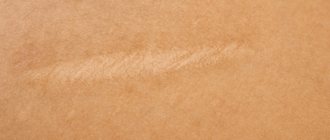The main cause of deformation of the anterior abdominal wall in young women with a normal fat layer is pregnancy. The skin and muscles of the anterior abdominal wall become excessively stretched and weakened. Tears in the subcutaneous connective tissue ensure that the skin and muscles remain relaxed after childbirth, and wrinkles appear, which subsequently form folds and sagging.
The tendency of women to endocrine, hormonal and metabolic disorders causes excessive deposition of fat in the subcutaneous tissue and subsequent sagging of the abdomen.
Abdominoplasty, as a rule, leads to good results, but it must be borne in mind that after surgery a scar remains on the abdomen, which, depending on the severity of the problem and the method of performing the operation, can have a different size.
WHO IS ABDOMINOPLASTY FOR?
Patients with indications for abdominoplasty are people (most often women) who cannot achieve the desired effect with diet and exercise.
Abdominoplasty is indicated for women who have had a pregnancy that has caused stretching of the abdominal muscles and skin. It can also be recommended for loss of skin elasticity, which usually occurs with the acquisition of excess weight or with age. In men, abdominoplasty is sometimes indicated after excessive weight loss.
The operation is contraindicated for women planning to undergo a pregnancy in the future, since the vertical abdominal muscles, tightened through the operation, can stretch again during pregnancy.
Abdominoplasty is not recommended for people planning to lose weight, since in this case the result achieved through the operation can be significantly spoiled.
Rehabilitation after plastic surgery
Strict adherence to your doctor's recommendations will help you minimize the risk of postoperative complications. After the completion of the rehabilitation period, you will look attractive and deserve the admiration of others.
Rehabilitation period after abdominoplasty, liposuction:
- Wearing a postoperative bandage or compression garments for 2-3 weeks during the day; in the next 1-2 months, the bandage must be worn during intense physical activity.
- Limiting physical activity for 1 month.
- You can take a shower the next day after discharge; after a shower, you need to change the dressings.
- Within 3 days after discharge, it is necessary to measure body temperature twice a day: at a temperature of 37.50C and above, you must contact the attending or operating doctor.
- For 2-3 days after discharge, for pain in the area of the surgical wound, you can take painkillers (Pentalgin, Ketanov, Ketorol, etc.).
- Sutures are removed 7-8 days after surgery.
During the first day after surgery, the patient needs to be prepared for the fact that the soft tissues in the abdominal area will be swollen, and there will also be pain along the surgical suture and the presence of bruises. This is a normal reaction of the body to surgery and should not cause concern.
In most cases, suture removal occurs 7-9 days after surgery, depending on the progress of healing. This occurs especially for a long time in obese and smoking patients. Therefore, during the first 6 weeks of the rehabilitation period you should not smoke.
For the first time after surgery, it is recommended to minimize any physical activity, especially take care of your abs and maintain bed rest. This will help prevent fluid accumulation and speed up the recovery process. Light exercise is possible after a month, and you will be able to return to full-fledged sports no earlier than 1.5 months (6 weeks) after abdominoplasty.
In the first month and a half after surgery, wearing compression garments or a corset is highly recommended. You cannot lift weights or strain your stomach.
You should not worry that at first the postoperative scar will stand out against the background of the rest of the skin. Its resorption occurs gradually: it takes about a year for the suture scar to retract to the level of healthy skin and acquire a natural, inconspicuous color. In the future, it will become almost invisible, and since the incision for abdominoplasty is made horizontally, at the very bottom of the abdomen, it will be covered with underwear. The rehabilitation process can be accelerated using hardware techniques that have a lymphatic drainage function (on the 14th day after surgery, you can do lymphatic drainage massage using an LPG device).
The results of abdominoplasty will last for a long time - and playing sports and controlling your own body weight will help you with this. When a child is born, of course, the skin will stretch, but not as much as before the operation.
Rehabilitation period after augmentation mammoplasty, breast lift:
- Wearing compression garments for a month.
- Limiting physical activity for 1 month.
- You can take a shower from the next day after discharge, after a shower you need to change the dressings, and avoid baths, saunas, and hot baths for a month.
- Within 3 days after discharge, it is necessary to measure body temperature twice a day: at a temperature of 37.50C and above, you must contact the attending or operating doctor.
- For 2-3 days after discharge, for pain in the area of the surgical wound, you can take painkillers (Pentalgin, Ketanov, Ketorol, etc.).
- Sutures are removed 7-8 days after surgery.
Upon completion of the operation, the patient is put on special underwear. It is called compression. It is worn for about a month throughout the entire rehabilitation period. As soon as the anesthesia wears off, patients initially feel chest pain. Analgesics are used to relieve pain symptoms. It is not recommended to get out of bed in the first hours after surgery. The patient spends about a day in the hospital, after which he returns home.
Unpleasant pain bothers the patient for a week; rehabilitation during this period is characterized by the use of painkillers. You should not self-medicate. All medications are prescribed by your doctor, and you must strictly adhere to all his recommendations. New sensations appear: the breasts become more sensitive to touch, and the nipple area loses its original sensitivity. All these phenomena are temporary and will pass as soon as the surgical sutures heal. The volume of the mammary glands is initially greater than what was planned before the operation. This should not be frustrating: the increase during this period is due to swelling, which will subside in a few weeks.
Rehabilitation after breast augmentation includes monitoring the postoperative suture. It will be noticeable for about 4-6 months. Scar healing is characterized by redness and thickening. This is normal, so there is no need to worry. Only after a year the seam will turn into a thin, almost invisible thread. After a breast lift, the vertical scar will be corrugated and the lower pole of the breast will be slightly beveled. Within a month, the corrugation will straighten out, and the lower pole will fill up and the mammary gland will acquire a beautiful natural shape.
For about two months after the operation, you should not engage in sports or physically strain the body. This is especially true for the shoulder girdle. It is also recommended not to smoke or drink alcohol for the first weeks after surgery.
Rehabilitation period after upper or lower blepharoplasty:
- Cold on the upper eyelids at intervals of 20 minutes per hour for 3 hours 3 times a day for 2 days (on the eve of the operation, you need to prepare an ice pack at home - it is best to use a condom with water, a ball of water or frozen peas).
- Refrain from baths, saunas, hot baths for a month, limit yourself to showering.
- Within 3 days after discharge, it is necessary to measure body temperature twice a day: at a temperature of 37.50C and above, you must contact the attending or operating doctor.
- For 2-3 days after discharge, you can take painkillers for pain in the area of the surgical wound.
- Sutures are removed 7-8 days after surgery.
In the postoperative period, moderate pain may be observed, some discomfort may be felt in the form of heaviness of the eyelids, and mild eye irritation. At the very beginning of the postoperative period, maximum rest is needed. It is recommended to avoid any physical activity, watching TV, reading books, eating highly spicy, salty, fatty, fried foods, and alcohol.
Most often, after blepharoplasty, swelling and bruising may occur in the area of the operated eyelid. During the first hours, you will have cold (an ice pack) applied to the surgical site to reduce the severity of post-operative swelling.
The rehabilitation period after blepharoplasty is 10-16 days. It is recommended not to wear contact lenses for the first 2 weeks after surgery. You can apply makeup no earlier than after 7 days. After surgery, thin, barely noticeable postoperative scars may remain at the incision site, which fade over time and practically disappear after two to three months. Bruises around the eyes disappear on average after 10-16 days.
To shorten the recovery time after blepharoplasty, the doctor may prescribe special physical procedures (microcurrents).
Rehabilitation period after lifting (tightening) of the soft tissues of the face and (or) neck:
- Limiting physical activity for 1 month.
- You can take a shower the next day after discharge; after a shower, you need to change the dressings.
- Within 3 days after discharge, it is necessary to measure body temperature twice a day: at a temperature of 37.50C and above, you must contact the attending or operating doctor.
- For 2-3 days after discharge, for pain in the area of the surgical wound, you can take painkillers (Pentalgin, Ketanov, Ketorol, etc.)
- Avoid hot and spicy foods and alcohol for 2-3 days.
- Sutures are removed 7-8 days after surgery.
Immediately after a facelift, patients experience temporary pain that goes away after a few days. Swelling after surgery reaches its maximum on the third day.
To reduce the risk of complications after surgery and to speed up the recovery of the body, it is necessary to fully comply with the doctor’s recommendations, which include, in particular, stopping smoking, limiting the intake of very hot, spicy or salty foods, and alcohol for two weeks. After the first dressing, painkillers are prescribed, then dressings are carried out on an outpatient basis. Swelling after surgery usually decreases between the tenth and twentieth days. To achieve better results in the early postoperative periods, a course of physiotherapy (microcurrents) is required, and after 2 weeks a course of lymphatic drainage massage is possible.
It is already possible to return to your usual lifestyle, but with some restrictions, 10-14 days after the operation. Physical activity and sports are allowed only one month after the operation. During this period, it is advisable to refrain from visiting the bathhouse, solarium and avoid exposure to direct sunlight on the area of postoperative scars. Swelling subsides approximately two months after surgery, but the final result of a circular facelift can only be enjoyed after 6-12 months.
Rehabilitation period after ear surgery:
- Wear the elastic bandage continuously for 3 weeks, then wear it at night for a week.
- You can take a shower from the next day after discharge, after a shower you need to change the dressings, and avoid baths, saunas, and hot baths for a month.
- Within 3 days after discharge, it is necessary to measure body temperature twice a day: at a temperature of 37.50 C and above, you must contact the attending or operating doctor.
- For 2-3 days after discharge, for pain in the area of the surgical wound, you can take painkillers (Pentalgin, Ketanov, Ketorol, etc.).
- Sutures are removed 7-8 days after surgery.
After the operation, the doctor puts a special protective bandage on the ears. Most likely, after observing you for a while, doctors will let you go home, although some patients may spend the night in the hospital. Regardless of the otoplasty technique used, an appropriate bandage is required to maintain the position of the ear without undue stress. To prevent swelling and for proper formation of the auricle, impregnated saline is placed in the grooves of the ear. modeling wool solution. The ears are examined on the first day after surgery. The next day, the patient is asked to bring a tennis tape or any other knitted elastic hair band to the first dressing. It is applied by the surgeon after the bandages are removed and left in place until the stitches are removed, for 1 week.
To prevent accidental ear injury for a month after otoplasty, the patient is advised to wear an elastic hair band. Some patients experience slight swelling for several weeks. Hematomas usually resolve within 7-10 days after surgery. During the recovery period, you should not lift heavy objects, frequently bend over, or overexert yourself. In most cases, you will be able to return to your normal daily routine in 5-7 days or even sooner. As a rule, the final result of the operation lasts for life.
Rehabilitation period after lipofilling of the legs:
- Limit physical activity for 14 days.
- You can take a shower the next day after discharge.
- After a shower, it is necessary to change the dressings.
- For 2-3 days after discharge, for pain in the area of the surgical wound, you can take painkillers (Pentalgin, Ketanov, Ketorol, etc.).
After lipofilling, the patient does not need postoperative care; there is no need to stay in the hospital. Therefore, you can return home immediately after the procedure. However, for several days after it is carried out, it is necessary to limit yourself from all kinds of physical activity. After this procedure, slight swelling appears, which disappears after 5-7 days. Punctures in the area where adipose tissue is inserted are hardly noticeable and heal within 7-10 days. If you don’t tell anyone about the procedure, then no one will guess the reason for your transformation. The result of this operation can be assessed only after four months or six months. This is explained by the fact that when transplanting fat tissue, a little more fat is injected into the patient than necessary, since only about 60% of the total volume of injected fat cells survives. Some time must pass for the excess fat cells to die, and for others to take root and fulfill their purpose. However, the visible effect is noticeable a month after the operation: maximum natural body contours and youthful skin.
INDICATIONS FOR ABDOMINAL PLASTY
· saggy abdomen resulting from weight loss, age-related changes or pregnancy;
· flabbiness and divergence of the abdominal muscles, leading to prolapse of the internal organs;
Flabbiness of the abdomen with a weakly defined layer of fat;
· scar deformities caused by previous operations;
· formation of cicatricial stretch marks of the skin, especially around the navel and below;
· presence of unaesthetic scars on the abdomen after other surgical interventions.
WHAT IS NEEDED FOR ABDOMINOPLASTY
· absence of any acute or exacerbation of chronic diseases at the time of surgery (for example, colds);
· 10 days before surgery you should stop taking medications containing aspirin;
· Smoking is strictly prohibited 10 days before surgery and for 3-4 weeks after surgery;
· during the last 1 - 2 days before surgery (as directed by the doctor), it is recommended to only drink liquids;
· You should take a bath the night before;
· The operation is performed on an empty stomach (use 1/2 glass of water to clean your teeth and mouth).
FEATURES OF THE OPERATION
· before surgery, the defect is thoroughly assessed and incision lines are outlined;
· a horizontal, vertical or combined (horizontal-vertical) incision is made on the anterior abdominal wall;
· excess tissue below the navel is excised and removed along with scar stretch marks of the skin;
· if there are scars after other surgical interventions, the surgeon, if possible, removes them as well;
· when the rectus abdominis muscles diverge, they are brought together and strengthened. The muscles of the anterior abdominal wall that have separated from each other during pregnancy are strengthened until their normal position and tone are restored;
· at the end of the operation, cosmetic sutures are applied, drainage is installed, a bandage and bandage are applied.
POSTOPERATIVE PERIOD
· Bed rest is recommended during the first 24 hours; getting up is usually allowed the next day after surgery;
· drinking (simple still water) is allowed after the doctor’s permission, light food after passing gases;
· it is necessary to constantly wear the bandage for 4 - 6 weeks (sometimes, as directed by the doctor, up to 2 - 3 months);
· in the first days you may experience malaise and a slight increase in body temperature.
POSSIBLE SIDE EVENTS
· the development of postoperative complications is associated with the thickness of fatty tissue, the patient’s weight, the presence of concomitant diseases, and smoking;
· during the first 2 - 3 weeks, general malaise, swelling of the tissues, as well as pain during movements are allowed, which gradually disappear, disappearing completely 2 - 3 months after the operation;
· during the first 1 - 3 months there is a decrease in sensitivity in the suture area. In this regard, you should not use a heating pad with hot water, too hot showers or baths.
It is recommended to avoid direct sunlight. Full or partial abdominoplasty achieves good results in patients with weakened abdominal muscles or excess skin. In most cases, the effect lasts for a long time if you follow a balanced diet.
The final result of the operation depends not only on the skill of the surgeon, but also on the individual characteristics of the patient and his compliance with all the doctor’s recommendations.
Abdominoplasty (abdominoplasty)
Abdominoplasty (abdominoplasty) is a plastic surgery that can completely restore the tone of the abdominal muscles, remove excess fat and skin from the lower abdominal wall, and give the shape of the abdomen an aesthetic appearance.
The Medical Plastic Surgery Clinic employs highly qualified plastic surgeons, some of the best specialists in abdominoplasty , who can perform corrective surgery of any complexity. The presence of modern dissectors makes it possible to reduce the traumatic nature of tissue mobilization to a minimum, and tissue dissection without blood loss and hematomas.
During preliminary procedures, surgery and post-operative care, innovative medical technologies and the best certified drugs are used.
Indications for tummy tuck are:
- pronounced sagging of the abdominal skin and the presence of a fatty apron after several pregnancies, sudden weight loss or due to age-related changes;
- stretching (diastasis) of the abdominal muscles, leading to lowering of the internal organs;
- any scarring below or above the navel (may reach the level of the ribs);
- the presence of unaesthetic scars on the abdomen after other surgical operations;
- stretch marks after pregnancy.
The polyvalent training of surgeons at the Medical Center allows for simultaneous operations (2-3 operations at once).
Contraindications for tummy tuck:
- Possibility of pregnancy. If you had an abdominoplasty, but then carried a child, after pregnancy a boomerang effect may appear: the muscles of the abdominal wall will stretch again and the effect of tummy tuck will disappear;
- Obesity above the third degree. Tummy tuck is aimed at treating obesity and overweight, but before resorting to plastic surgery, it is necessary to determine the cause of obesity. It is also recommended to lose weight before the operation, so that later, when losing weight, the abdominal muscles do not sag again;
- Decompensated diabetes mellitus;
- Heart or pulmonary failure.
Often, in case of obesity (even the second degree), indications for abdominoplasty are given. In this case, devastating liposuction of the adjacent areas of the abdomen is performed. This is necessary to equalize the thickness of the flaps of the skin-fat layer when they are connected and transposed (moved) of the navel.
In cases where surgery to remove a hernia , the latest innovative developments of scientists in the field of implantology and herniology are used. To strengthen the abdominal wall and prevent the re-formation of a hernia, various mesh prosthetic implants of the latest generation are used; their main advantages are inertness, durability and antibacterial effect.
In rare cases, in some patients, preliminary removal of the omentum by abdominal laparoscopy is possible or necessary if ultrasound diagnostics confirm its excessive mass.
In the postoperative period it is necessary to consider:
- Abdominoplasty leaves a scar on the abdomen (mostly horizontal, less often vertical). Over time, the scar will fade and will not be particularly noticeable.
- Some areas of the abdominal wall may temporarily (and in rare cases permanently) lose sensation. Therefore, in the postoperative period it is not recommended to carry out warming procedures, including using hot water. It is also recommended to avoid direct sunlight.
- After surgery, bruising and swelling of the abdominal wall may persist for up to 2 weeks.
- Light physical activity can be started no earlier than a month and a half after the tummy tuck is performed.
Of course, to maintain a neat appearance of the abdomen, you need to rely not only on surgery. Constant physical activity, exercise, and a balanced diet will be necessary after surgery. In any case, you should consult, undergo proper further examination and clarify the combination of correction individually.
Medical plastic surgery specialists offer the most competent solution to the problem - the safest surgery and the necessary postoperative observation .











